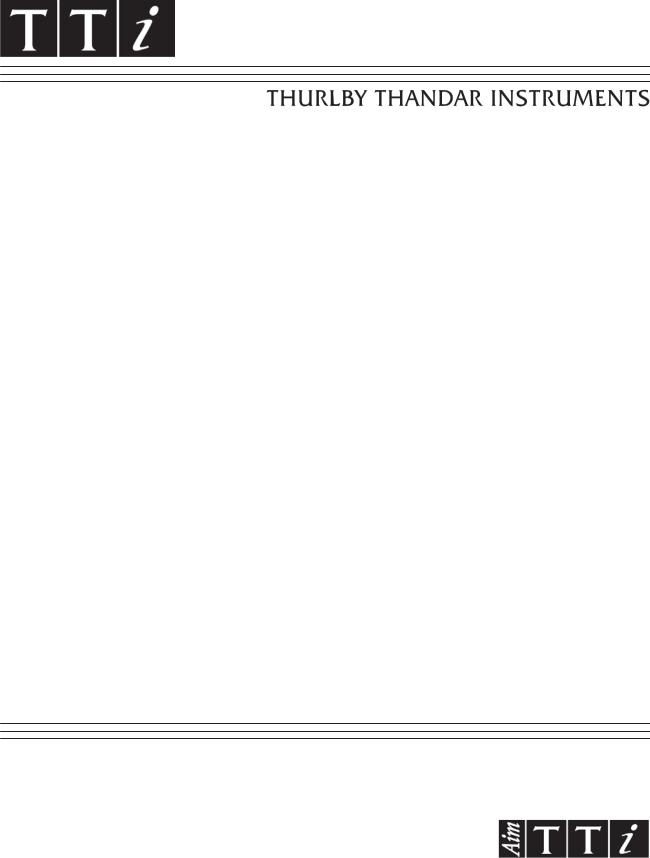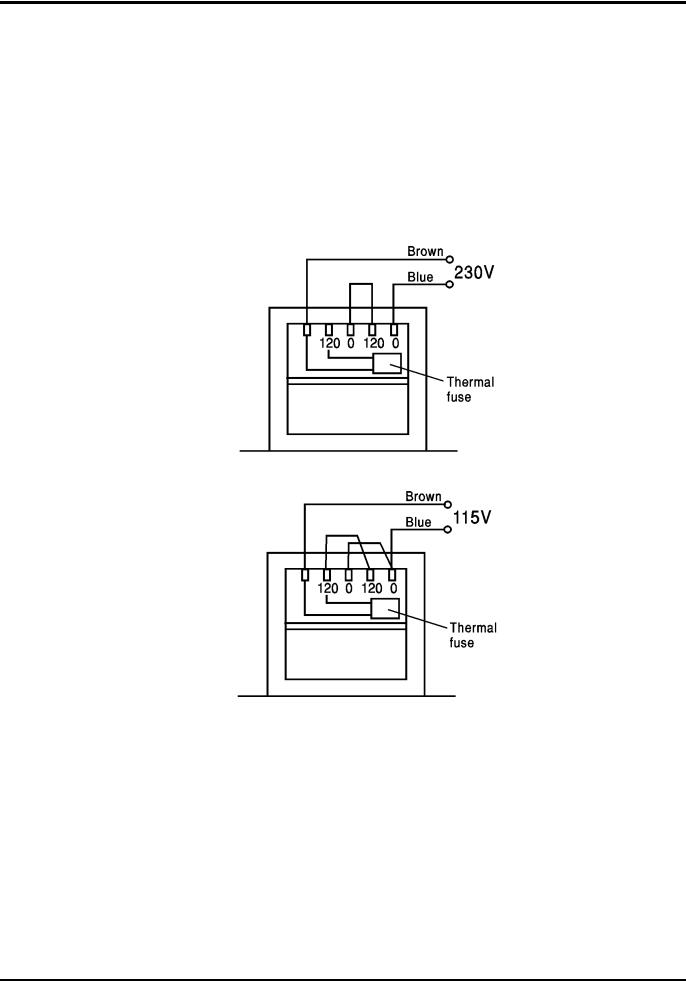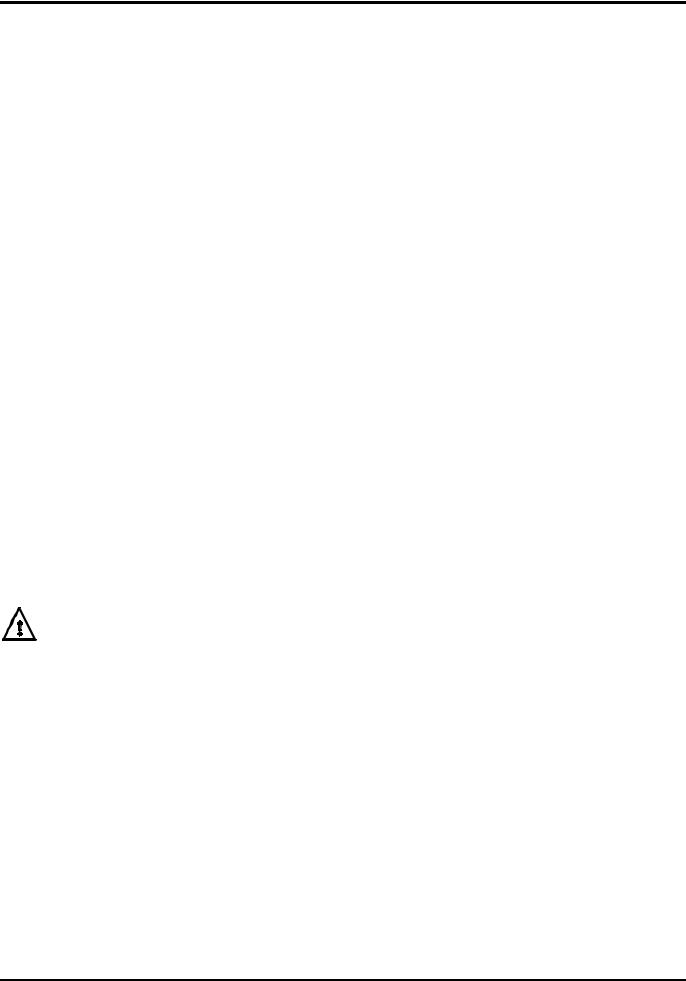Thurlby Thandar Instruments TG120 User Manual [en, de, fr, it]

TG120
20MHz Function Generator INSTRUCTION MANUAL

|
Table of Contents |
Introduction |
1 |
Specification |
2 |
EMC |
4 |
Safety |
5 |
Installation |
6 |
Operation |
7 |
Maintenance |
8 |
Instructions en Francais |
9 |
Bedienungsanleitung auf Deutsch |
13 |
Istruzioni in Italiano |
17 |
Instrucciones en Español |
21 |
Introduction
This instrument is a 20MHz function generator with waveforms of sine, square, triangle, ramp, pulse and DC from a variable amplitude 50Ω output. A TTL output is also provided.
The frequency range is 0.2Hz to 20MHz selected by an eight decade range multiplier and calibrated vernier. The sweep input can be used to give a >20:1 frequency change within a selected range.
The generator output level is 20Vpk-pk maximum from a 50Ω source. The level is set via switched attenuators plus vernier with a total range of 66dB. DC offset is vernier adjustable over a ±10V range with 0V defined by a centre detent.
A switchable symmetry control with a 6:1 range permits ramp and pulse waveforms to be produced.
1

FREQUENCY |
Specification |
|
|
Frequency Range: |
0.2Hz to 20MHz in 8 overlapping decade ranges with fine adjustment by a vernier. |
Vernier Range: |
>10:1 on each range. |
Vernier Accuracy: |
Typically ± 5% of full scale. |
SWEEP MODE (EXTERNAL) |
|
Sweep Range: |
Typically >20:1. |
Input Impedance: |
82 kΩ |
Input Sensitivity: |
Typically 0 to 2V for 10:1 sweep. |
Maximum Allowable |
|
Input Voltage: |
±10V |
Maximum Slew Rate |
|
of Sweep Voltage: |
0.1V/us |
OPERATING MODES
(Specifications apply for the top decade of each frequency range and output 10V peak-to-peak into 50Ω termination).
SINE |
|
Distortion: |
Typically 2% on 200, 2k and 20k ranges. |
Amplitude Flatness: |
± 0.2dB to 200kHz; ± 2dB to 20MHz. |
TRIANGLE |
|
Linearity: |
Typically 99% on kHz ranges. |
SQUAREWAVE |
|
Rise and Fall Times: |
<22ns |
DC |
|
Range: |
±10V from 50Ω |
SYMMETRY |
|
Symmetry Range: |
Typically variable from 1:6 to 6:1 up to 500kHz. |
OUTPUTS (50Ω)
Three switch-selectable ranges with 26dB vernier control within each attenuator range.
0dB Range: –20dB Range: –40dB Range:
DC Offset Control Range:
TTL
1V to 20V peak-to peak from 50Ω (0·5V to 10V into 50Ω). 100mV to 2V peak-to-peak (50mV to 1V into 50Ω)
10mV to 0.2V peak-to-peak (5mV to 0.1V into 50Ω)
±10V from 50Ω. DC offset plus signal peak limited to ±10V (± 5V into 50Ω).
DC offset plus waveform attenuated proportionally in –20dB and –40dB position.
Capable of driving 4 standard TTL loads.
GENERAL
Power: |
220V-240V AC or 110-120V AC ±10%, 50/60Hz; 30VA max. Installation Category II. |
|
Operating Range: |
+5ºC to + 40ºC, 20% to 80% RH. |
|
Storage Range: |
–40ºC to +70ºC |
|
Environmental: |
Indoor use at altitudes up to 2000m, Pollution Degree 2. |
|
Electrical Safety: |
Complies with EN61010-1. |
|
EMC: |
Complies with EN61326. |
|
Size: |
220(W) x 82(H) x 230(D) mm, (10.3 x 3.4 x 9.2”) excluding feet. |
|
Weight: |
1.5 Kg (3.3lb). |
|
|
|
|
2 |
|
|

EC Declaration of Conformity
We Thurlby Thandar Instruments Ltd
Glebe Road
Huntingdon
Cambridgeshire PE29 7DR
England
declare that the
TG120 20MHz Function Generator
meets the intent of the EMC Directive 2004/108/EC and the Low Voltage Directive 2006/95/EC. Compliance was demonstrated by conformance to the following specifications which have been listed in the Official Journal of the European Communities.
EMC |
|
|
|
|
Emissions: |
a) |
EN61326-1 (2006) |
Radiated, Class B |
|
|
b) |
EN61326-1 (2006) |
Conducted, Class B |
|
|
c) |
EN61326-1 (2006) |
Harmonics, referring to EN61000-3-2 (2006) |
|
Immunity: |
EN61326-1 (2006) Immunity Table 1, referring to: |
|||
|
a) |
EN61000-4-2 (2009) Electrostatic Discharge |
||
|
b) |
EN61000-4-3 (2006) |
Electromagnetic Field |
|
|
c) |
EN61000-4-11 (2004) Voltage Interrupt |
||
|
d) |
EN61000-4-4 (2004) |
Fast Transient |
|
|
e) |
EN61000-4-5 (2006) |
Surge |
|
|
f) |
EN61000-4-6 (2009) |
Conducted RF |
|
Performance levels achieved are detailed in the user manual.
Safety
EN61010-1 Installation Category II, Pollution Degree 2.
CHRIS WILDING TECHNICAL DIRECTOR
2 January 2013
3

EMC
This instrument has been designed to meet the requirements of the EMC Directive 2004/108/EC.
Compliance was demonstrated by meeting the test limits of the following standards:
Emissions
EN61326-1 (2006) EMC product standard for Electrical Equipment for Measurement, Control and Laboratory Use. Test limits used were:
a)Radiated: Class B
b)Conducted: Class B
c)Harmonics: EN61000-3-2 (2006) Class A; the instrument is Class A by product category.
Immunity
EN61326-1 (2006) EMC product standard for Electrical Equipment for Measurement, Control and Laboratory Use.
Test methods, limits and performance achieved are shown below (requirement shown in brackets):
a)EN61000-4-2 (2009) Electrostatic Discharge : 4kV air, 4kV contact, Performance A (B).
b)EN61000-4-3 (2006) Electromagnetic Field:
3V/m, 80% AM at 1kHz, 80MHz – 1GHz: Performance A (A) and 1.4GHz to 2GHz: Performance A (A); 1V/m, 2.0GHz to 2.7GHz: Performance A (A).
c)EN61000-4-11 (2004) Voltage Interrupt: ½ cycle and 1 cycle, 0%: Performance A (B); 25 cycles, 70% and 250 cycles, 0%: Performance B (C).
d)EN61000-4-4 (2004) Fast Transient, 1kV peak (AC line), 0·5kV peak (DC Outputs), Performance B (B).
e)EN61000-4-5 (2006) Surge, 0·5kV (line to line), 1kV (line to ground), Performance A (B).
f)EN61000-4-6 (2009) Conducted RF, 3V, 80% AM at 1kHz (AC line only; DC Output connections <3m, therefore not tested), Performance A (A).
According to EN61326-1 the definitions of performance criteria are:
Performance criterion A: ‘During test normal performance within the specification limits.’
Performance criterion B: ‘During test, temporary degradation, or loss of function or performance which is self-recovering’.
Performance criterion C: ‘During test, temporary degradation, or loss of function or performance which requires operator intervention or system reset occurs.’
Cautions
To ensure continued compliance with the EMC directive the following precautions should be observed:
a)connect the generator to other equipment using only high quality, double-screened cables.
b)after opening the case for any reason ensure that all signal and ground connections are remade correctly before replacing the covers. Always ensure all case screws are correctly refitted and tightened.
c)In the event of part replacement becoming necessary, only use components of an identical type, see the Service Manual.
4

Safety
This instrument is Safety Class I according to IEC classification and has been designed to meet the requirements of EN61010-1 (Safety Requirements for Electrical Equipment for Measurement, Control and Laboratory Use). It is an Installation Category II instrument intended for operation from a normal single phase supply.
This instrument has been tested in accordance with EN61010-1 and has been supplied in a safe condition. This instruction manual contains some information and warnings which have to be followed by the user to ensure safe operation and to retain the instrument in a safe condition.
This instrument has been designed for indoor use in a Pollution Degree 2 environment in the temperature range 5°C to 40°C, 20% - 80% RH (non-condensing). It may occasionally be subjected to temperatures between +5°C and –10°C without degradation of its safety. Do not operate while condensation is present.
Use of this instrument in a manner not specified by these instructions may impair the safety protection provided. Do not operate the instrument outside its rated supply voltages or environmental range.
WARNING! THIS INSTRUMENT MUST BE EARTHED
Any interruption of the mains earth conductor inside or outside the instrument will make the instrument dangerous. Intentional interruption is prohibited. The protective action must not be negated by the use of an extension cord without a protective conductor.
When the instrument is connected to its supply, terminals may be live and opening the covers or removal of parts (except those to which access can be gained by hand) is likely to expose live parts. The apparatus shall be disconnected from all voltage sources before it is opened for any adjustment, replacement, maintenance or repair.
Any adjustment, maintenance and repair of the opened instrument under voltage shall be avoided as far as possible and, if inevitable, shall be carried out only by a skilled person who is aware of the hazard involved.
If the instrument is clearly defective, has been subject to mechanical damage, excessive moisture or chemical corrosion the safety protection may be impaired and the apparatus should be withdrawn from use and returned for checking and repair.
Make sure that only fuses with the required rated current and of the specified type are used for replacement. The use of makeshift fuses and the short-circuiting of fuse holders is prohibited.
Do not wet the instrument when cleaning it.
The following symbols are used on the instrument and in this manual:-
l
Caution - refer to the accompanying documentation, incorrect operation may damage the instrument.
terminal connected to chassis ground.
mains supply OFF.
mains supply ON. alternating current.
5

Installation
MAINS OPERATING VOLTAGE
The operating voltage of the instrument is shown on the rear panel. Should it be necessary to change the operating voltage from 230V to 115V or vice-versa, proceed as follows:
1.Disconnect the instrument from all voltage sources.
2.Remove the 4 screws which hold the upper and lower case halves together and lift off the case upper.
3.Change the transformer connections following the diagrams below.
230V Operating - Primaries in series
115V Operation - Primaries in parallel
4.Reassemble in the reverse order.
5.To comply with safety standard requirements the operating voltage marked on the rear panel must be changed to clearly show the new voltage setting.
MAINS LEAD
When a three core mains lead with bare ends is provided it should be connected as follows:-
Brown |
- |
Mains live |
Blue |
- |
Mains neutral |
Green/Yellow - |
Earth |
|
WARNING! THIS INSTRUMENT MUST BE EARTHED
Any interruption of the mains earth conductor inside or outside the instrument will make the instrument dangerous. Intentional interruption is prohibited.
6

Operation
POWER
The ON/OFF switch is on the rear panel of the instrument.
FREQUENCY SELECTION
Frequency range is selected by an eight position multiplier switch with fine adjustment by calibrated vernier.
SYMMETRY
A slide switch selects the symmetry control which varies the duty cycle 1:6 to 6:1 to produce sawtooth and variable pulse-width waveforms.
Note: The symmetry of the Aux Output does not vary when Sine or Triangle are selected because the Aux Output is generated by a zero crossing comparator.
FUNCTION SELECTION
The output waveform shape is selected by a four position switch to give sine, square, triangle and DC. A DC level only is useful as it permits input threshold testing of a circuit without having to connect up an external supply.
MAIN OUTPUT
The amplitude of the 50 Ω MAIN output is controlled by the 3-position ATTENUATOR switches and AMPLITUDE control. Maximum output is 20 volts peak-to-peak from 50 Ω and 10 volts peak- to-peak when terminated with a 50 Ω load.
The AMPLITUDE control has greater than 26dB range and used in conjunction with the ATTENTUATORS a range of 0dB to -66dB can be achieved. This provides a range of 20V peak- to-peak down to 10mV peak-to-peak, or 10V peak-to-peak down to 5mV peak-to-peak into 50 Ω.
Greater attenuation can be achieved by using standard 50 Ω BNC attenuators. To maintain waveform integrity only 50 Ω cable should be used and the receiving end should be terminated with a 50 Ω load. The 50 Ω MAIN output will withstand a short circuit for a period of 2 minutes at maximum output and greater periods at lower output levels.
Do not apply external voltages to this output.
DC OFFSET
The DC OFFSET control has a range of ± 10 volts from 50 Ω in all output modes; the control has a centre detent for 0 volts. DC offset plus signal peak is limited to ± 10V (± 5V into 50 Ω). DC offset plus waveform is attenuated proportionally in the -20dB and -40dB positions.
AUX OUTPUT
The AUX output provides a fixed TTL pulse output at the same frequency and phase as the 50 Ω MAIN output and is capable of driving 4 standard TTL loads.
SWEEP INPUT
The generator frequency can be swept, DC programmed or modulated by a suitable control voltage applied to the SWEEP IN socket. The instrument sums the SWEEP IN voltage with the internal control voltage derived from the FREQUENCY vernier to determine the operating frequency. A positive voltage increases the frequency; for frequency control with positive-going DC inputs the vernier should therefore be set to the lower frequency limit of the range to be swept. For example, a 0V to +2V signal will sweep the generator 1 decade up from range minimum, set by the vernier, to range maximum.
7
